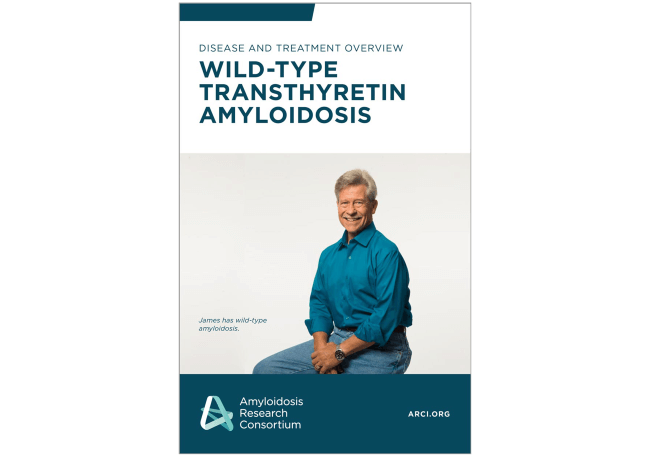
Wild-Type Amyloidosis
Wild-type ATTR Amyloidosis (ATTRwt) is age related and mainly affects the heart.
TTR is a natural protein made mostly in the liver. Its role is to transport the hormone thyroxine and retinol (Vitamin A) around the body, hence its name transthyretin. In ATTR amyloidosis, the TTR protein becomes unstable, misfolds and forms amyloid deposits in various organs of the body.
3D animated overview of ATTR amyloidosis
Two main types of ATTR amyloidosis:
- Wild-type ATTR amyloidosis (ATTRwt)
Develops with age; acquired not inherited - Hereditary ATTR amyloidosis (hATTR)
Caused by a faulty or mutated gene that is inherited, i.e. runs in the family
Learn more about hereditary ATTR
In ATTRwt, the natural TTR protein becomes unstable with age, making it prone to misfold and form amyloid deposits mainly in the heart, causing cardiomyopathy. ATTRwt is most commonly reported in men over the age of 60.
We believe that ATTRwt is massively under-diagnosed and is often the underlying cause of heart failure.
Wild-Type ATTR (ATTRwt) Educational Booklets
Ralph shares his journey to diagnosis and living with wild-type ATTR amyloidosis.
A patient’s experience living with wild-type ATTR amyloidosis
Symptoms usually start after the age of 60 and are mostly associated with cardiomyopathy. Amyloid deposits in the heart make the heart wall stiffen and work inefficiently. Eventually this leads to congestive heart failure with symptoms such as shortness of breath, leg swelling, fatigue, nausea and an irregular heartbeat or palpitations.
Recent studies have shown that other symptoms unrelated to the heart may also exist and in some cases often are present 8-10 years before heart-related symptoms, the most commonly reported is carpal tunnel syndrome.
If ATTR amyloidosis is suspected, a number of tests are carried out including an abdominal fat pad biopsy to confirm the presence of amyloid deposits.
Tests are also done to determine the effect of the amyloid deposits on the heart, nerves and other organs. These tests include blood, nerve and muscle tests, echocardiogram, MRI and other types of scans. In some cases, organ biopsies may also be completed to determine organ involvement. Some scans can help identify the type of amyloidosis and distinguish ATTR from AL amyloidosis in the heart. Doctors also use other tests, called immunohistochemistry and mass spectrometry, to differentiate between ATTR and AL amyloidosis.
To distinguish between wild-type and hereditary ATTR amyloidosis, a blood test to screen for genetic mutations causing hATTR is necessary. The absence of these genetic mutations will confirm a diagnosis of wild-type ATTR amyloidosis.
In ATTR amyloidosis there are several different therapeutic approaches, which aim to do one of the following:
- Stabilizing the TTR protein
- Stopping the production of TTR protein
- Removing the amyloid deposits
Stabilizing the TTR protein: The approach of TTR stabilizers is to stop the TTR protein from forming amyloid deposits. There are several drugs which aim to treat ATTR in this manner:
- Diflunisal – Approved in the U.S. by the FDA as a non-steroidal, anti-inflammatory drug (NSAID) that has shown to bind to the TTR protein in the blood and may thereby prevent the formation of amyloid.
- Vyndaqel/Vyndamax (tafamidis) – Approved on May 3, 2019 for the treatment of transthyretin amyloidosis cardiomyopathy (ATTR-CM) – view factsheet
- Attruby (acoramidis) – Approved by the FDA for use in the U.S., Attruby is a TTR stabilizer developed for treating patients with transthyretin amyloidosis (ATTR) who have heart involvement (cardiomyopathy) – view factsheet
Stopping the production of TTR protein: The approach in stopping production of TTR proteins is through ‘gene silencing.’ Novel treatments known as “gene silencers” have shown promising results in clinical studies. They prevent TTR protein production by blocking the TTR gene. The gene silencing drug Vutrisiran (Amvuttra) has been approved for use for ATTR cardiomyopathy.
Drug factsheet:
- Vutrisiran (Amvuttra) — view factsheet
Removing amyloid deposits: The approach in removing amyloid deposits aims to make amyloid fibrils easier for the body to identify and remove from organs. There are currently no approved drugs aimed at removing amyloid deposits in wild-type ATTR.
Drug status report:
- PRX004 – Currently being tested in clinical trials
Supportive treatment: Although they do not address the underlying cause, supportive treatments are important to help alleviate symptoms and improve quality of life. Overall, factors such as age, general health and extent of organ damage are taken into account when deciding on treatment.
Amyloidosis is a multi-system disease, meaning it affects multiple organs. It is important to be seen at a center that has experience in diagnosing and treating your type of amyloidosis. These centers will have a group of different specialists (i.e., cardiologist, hematologist, neurologist) who will be able to provide a comprehensive evaluation and treatment plan. Learn more about ARC’s treatment center finder MAP here.
Learning about clinical trials can be an important part of your care. In a rare disease such as amyloidosis, treatment options are often limited, and clinical trials may be the best way for you to access new therapies. To learn more about the basics of clinical trials, click here.




